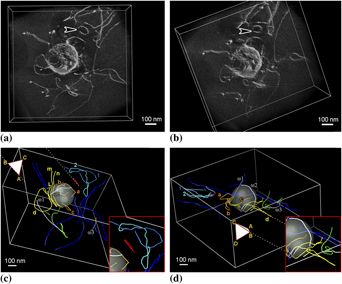Crossref Citations
This article has been cited by the following publications. This list is generated based on data provided by
Crossref.
Kacher, Josh
Liu, Grace S.
Martin, May
and
Robertson, I.M.
2011.
Effect of Ion Irradiation on Dislocation Processes in Stainless Steel.
MRS Proceedings,
Vol. 1363,
Issue. ,
Robertson, Ian M.
Schuh, Christopher A.
Vetrano, John S.
Browning, Nigel D.
Field, David P.
Jensen, Dorte Juul
Miller, Michael K.
Baker, Ian
Dunand, David C.
Dunin-Borkowski, Rafal
Kabius, Bernd
Kelly, Tom
Lozano-Perez, Sergio
Misra, Amit
Rohrer, Gregory S.
Rollett, Anthony D.
Taheri, Mitra L.
Thompson, Greg B.
Uchic, Michael
Wang, Xun-Li
and
Was, Gary
2011.
Towards an integrated materials characterization toolbox.
Journal of Materials Research,
Vol. 26,
Issue. 11,
p.
1341.
Kacher, J.
Liu, G.S.
and
Robertson, I.M.
2012.
In situ and tomographic observations of defect free channel formation in ion irradiated stainless steels.
Micron,
Vol. 43,
Issue. 11,
p.
1099.
Kacher, Josh
and
Robertson, I.M.
2012.
Quasi-four-dimensional analysis of dislocation interactions with grain boundaries in 304 stainless steel.
Acta Materialia,
Vol. 60,
Issue. 19,
p.
6657.
Kacher, Josh
Liu, Grace
and
Robertson, I M
2012.
Proceedings of the 1st International Conference on 3D Materials Science.
p.
209.
Kacher, Josh
Liu, Grace
and
Robertson, IM
2013.
1stInternational Conference on 3D Materials Science.
p.
209.
Midgley, Paul A.
and
Saghi, Zineb
2013.
Electron tomography in solid state and materials science – An Introduction.
Current Opinion in Solid State and Materials Science,
Vol. 17,
Issue. 3,
p.
89.
Groh, Sébastien
2014.
Transformation of shear loop into prismatic loops during bypass of an array of impenetrable particles by edge dislocations.
Materials Science and Engineering: A,
Vol. 618,
Issue. ,
p.
29.
Kacher, Josh
and
Robertson, Ian M.
2014.
In situand tomographic analysis of dislocation/grain boundary interactions in α-titanium.
Philosophical Magazine,
Vol. 94,
Issue. 8,
p.
814.
LI, Mao-hua
YANG, Yan-qing
HUANG, Bin
LUO, Xian
ZHANG, Wei
HAN, Ming
and
RU, Ji-gang
2014.
Development of advanced electron tomography in materials science based on TEM and STEM.
Transactions of Nonferrous Metals Society of China,
Vol. 24,
Issue. 10,
p.
3031.
Liu, G.S.
House, S.D.
Kacher, J.
Tanaka, M.
Higashida, K.
and
Robertson, I.M.
2014.
Electron tomography of dislocation structures.
Materials Characterization,
Vol. 87,
Issue. ,
p.
1.
Sato, K.
Miyazaki, H.
Gondo, T.
Miyazaki, S.
Murayama, M.
and
Hata, S.
2015.
Development of a novel straining holder for transmission electron microscopy compatible with single tilt-axis electron tomography.
Microscopy,
Vol. 64,
Issue. 5,
p.
369.
Sato, Kazuhisa
Semboshi, Satoshi
and
Konno, Toyohiko
2015.
Three-Dimensional Imaging of Dislocations in a Ti–35mass%Nb Alloy by Electron Tomography.
Materials,
Vol. 8,
Issue. 4,
p.
1924.
Yamasaki, S.
Mitsuhara, M.
Ikeda, K.
Hata, S.
and
Nakashima, H.
2015.
3D visualization of dislocation arrangement using scanning electron microscope serial sectioning method.
Scripta Materialia,
Vol. 101,
Issue. ,
p.
80.
He, Dong
Li, Qiang
Yan, Yu
Huang, Xiguang
and
Yasmeen, Tabassam
2016.
Study of plastic deformation mechanisms in TA15 titanium alloy by combination of geometrically necessary and statistically-stored dislocations.
International Journal of Materials Research,
Vol. 107,
Issue. 12,
p.
1073.
Kacher, Josh
and
Robertson, Ian M.
2016.
In situ TEM characterisation of dislocation interactions in α-titanium.
Philosophical Magazine,
Vol. 96,
Issue. 14,
p.
1437.
Hasezaki, Kana L.
Saito, Hikaru
Sannomiya, Takumi
Miyazaki, Hiroya
Gondo, Takashi
Miyazaki, Shinsuke
and
Hata, Satoshi
2017.
Three-dimensional visualization of dislocations in a ferromagnetic material by magnetic-field-free electron tomography.
Ultramicroscopy,
Vol. 182,
Issue. ,
p.
249.
Oveisi, Emad
Letouzey, Antoine
Alexander, Duncan T. L.
Jeangros, Quentin
Schäublin, Robin
Lucas, Guillaume
Fua, Pascal
and
Hébert, Cécile
2017.
Tilt-less 3-D electron imaging and reconstruction of complex curvilinear structures.
Scientific Reports,
Vol. 7,
Issue. 1,
Hasanzadeh, S.
Schäublin, R.
Décamps, B.
Rousson, V.
Autissier, E.
Barthe, M.F.
and
Hébert, C.
2018.
Three-dimensional scanning transmission electron microscopy of dislocation loops in tungsten.
Micron,
Vol. 113,
Issue. ,
p.
24.
Vaid, Aviral
Guénolé, Julien
Prakash, Aruna
Korte-Kerzel, Sandra
and
Bitzek, Erik
2019.
Atomistic simulations of basal dislocations in Mg interacting with Mg17Al12 precipitates.
Materialia,
Vol. 7,
Issue. ,
p.
100355.





